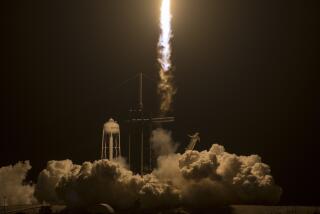Satellite Is Lost as Space Shuttle Tether Breaks
- Share via
KENNEDY SPACE CENTER, Fla. — A 12-mile tether holding a half-ton satellite broke off unexpectedly Sunday from the space shuttle Columbia. Both the shuttle and the seven astronauts aboard were safe.
Astronaut Jeffrey Hoffman shouted the news nearly five hours into the electrical experiment.
“The tether has broken at the boom! The tether has broken! It is going away from us!” Hoffman told Mission Control.
The satellite and dangling cord quickly drifted away from Columbia as all three objects sped around Earth at 17,500 mph.
Within several minutes, the satellite and tether were more than 18 miles away from Columbia--believed to be a safe distance.
NASA officials said they had no idea what went wrong.
It was about 7:30 p.m. CST that “we saw no data on the tether coming in,” said John Dumoulin, NASA spokesman at the Marshall Space Flight Center in Huntsville, Ala., where the procedure was being monitored.
Dumoulin said a video playback showed that the tether--which is “very, very small, about the width of a round toothpick”--was taut, having been reeled out about 12 of its 12.8 miles.
Then, “the video shows that it snapped. The tether recoiled away from the shuttle. The satellite and the tether moved away from the shuttle and continue to move away from the shuttle.”
Mission Control commentator James Hartsfield said the electricity-conducting cable apparently broke somewhere inside a 40-foot tower in the shuttle cargo bay. Only a small portion of the tether remained in the tower.
“Nothing moving at all,” reported shuttle commander Andrew Allen.
The astronauts were aware of the break almost instantly because of a sudden decrease in tether tension. In all the excitement, they bumped a camera and lost view of the satellite as it broke.
In the video later beamed down to Mission Control, the end of the severed copper, nylon and Teflon braided tether with the satellite resembled curly French fries.
“Those are some tether dynamics we did not want to see,” Mission Control said.
“Oh, well, we have demonstrated that you can generate a lot of electricity with tether and unfortunately we’ve also demonstrated that you can use tethers to launch a satellite into a much higher orbit,” Hoffman replied.
The tether was almost all the way out when it broke and, along with the satellite, had been generating more than 3,000 volts of electricity.
Until then, everything had been going well.
The satellite, a white metal ball 5 feet in diameter, rose slowly from a tower in the shuttle cargo bay Sunday afternoon and picked up speed as more and more of the 12.8-mile tether unwound from the huge, motorized spool.
An hour later, the satellite soared past the 840-foot mark, where it got stuck four years ago.
There had been a few surprises, but none of them serious.
The tether drifted to one side at first. It then began wiggling and, several minutes later, began swinging slightly back and forth. All the while, the satellite remained “rock-solid,” Hoffman said.
The motions eventually subsided as the motors on the reel began turning more quickly and releasing more tether.
Once the satellite was extended all the way out, it was to have generated 5,000 volts of electricity while sweeping through Earth’s magnetic field at 5 miles per second.
The $443-million, U.S.-Italian tethered system is equipped with numerous science instruments as well as electron guns. As current flows from the satellite down the tether to Columbia, the guns were supposed to shoot the electrons back into space, thereby closing the electrical circuit.
During the last flight of the satellite, the tether jammed because of a protruding bolt and the satellite never got farther than 840 feet from the shuttle.
This time, two critical computers jammed after Columbia blasted into orbit Thursday, delaying release of the satellite by one day. One of the computers malfunctioned again late Sunday morning--four hours before the satellite release--but the astronauts quickly fixed it.
More to Read
Sign up for Essential California
The most important California stories and recommendations in your inbox every morning.
You may occasionally receive promotional content from the Los Angeles Times.












